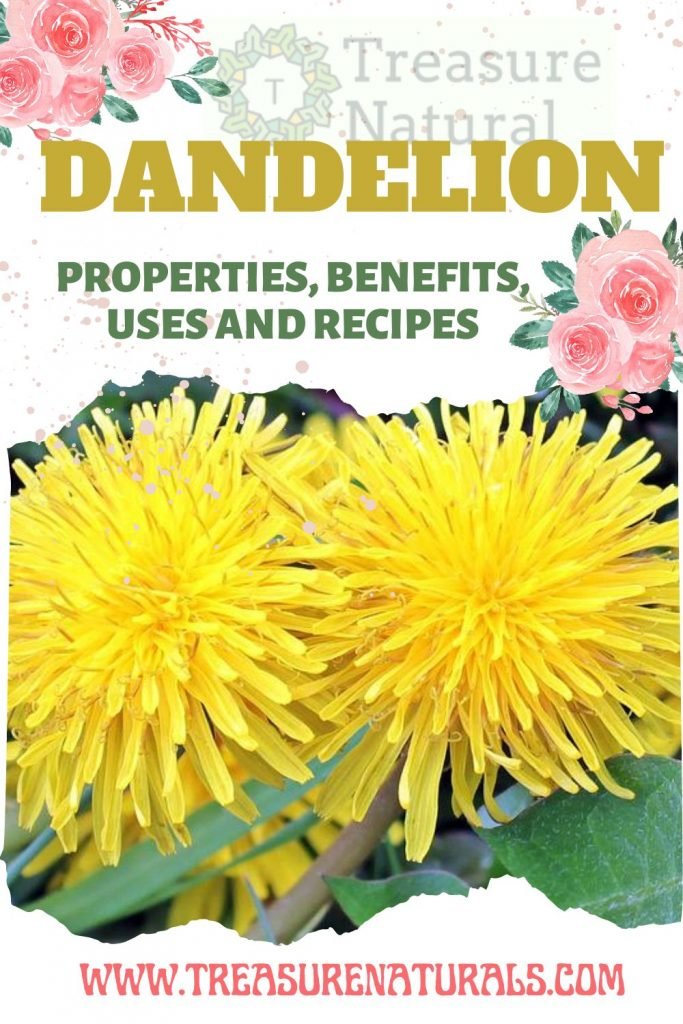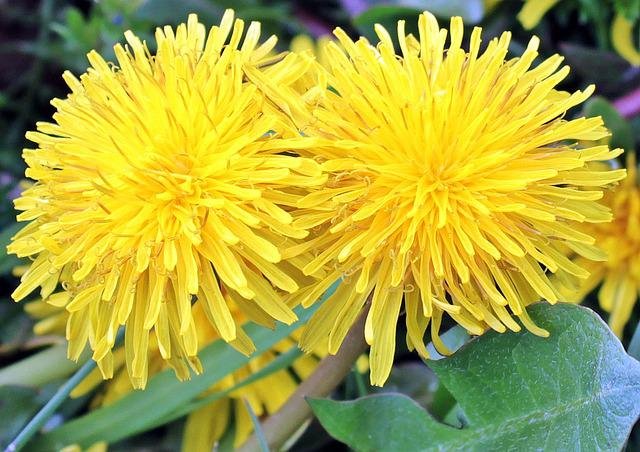
The common dandelion (botanical name Taraxacum officinale) is a spontaneous plant considered “purifying” par excellence: we discover all its properties (and four recipes).
The dandelion plant
In botany, the dandelion (Taraxacum officinale) is classified as a perennial herbaceous plant of modest size and height, belonging to the Asteraceae family. Widespread in all areas and altitudes, it grows in both temperate and cold climates and up to 2,000 meters above sea level.
It is characterized by a large tap root, which develops at reduced depths, and by the typical golden-yellow button inflorescence.
Present throughout the boot, it adapts well to any type of latitude: it is easy, in fact, to find it both in the plains and in the mountains, even at high altitudes, but it prefers the edges of paths, meadows and uncultivated land.
Dandelion: flower
The yellow-orange flower consists of a flower head surrounded by two orders of straight petals (bracts) until the seeds ripen, which then lower to allow the seeds to disperse, thanks to a kind of ‘parachute’. It is also called a dandelion.
Open during the day, it closes at night. Each stem carries a single flower and rises 1-10cm above the leaves. The stems and leaves emit a white latex when broken.
It is known by the popular name of ‘piscialetto’ due to the purifying and diuretic properties of the root.
Dandelion: shower head
Its yellow flowers ripen and transform into impalpable and delicate white spheres called dandelions. In fact, a breath is enough to make them flake and fly away.
These are globes containing many single-seeded fruits, called achenes. Each achene is attached to a stem and a small, very fine tuft, similar to hair, which acts as a parachute and allows it to be dispersed over long distances thanks to the wind.
Impossible not to know them, we all had fun with them as children!
The story of the dandelion or dandelion
In the Middle Ages, dandelion was used as an effective remedy for liver and kidney disorders, perhaps due to its intense ‘yellow’ color reminiscent of bile.
In fact, over the centuries, science proved its effectiveness and between 1500-1600 several naturalists and pharmacists recognized dandelion as diuretic and even wound healing properties. For similar reasons, Chinese medicine has always made extensive use of it.
Dandelion: properties of leaves and roots
Taraxacum officinalis is used in all its parts, although the most precious part, the one that contains the purifying properties in the most concentrated form, is the root.
The leaves of this natural cooking ingredient can be eaten in salads. It is advisable to use the younger ones because they are more tender and less bitter.
The older ones, which are those close to the base of the plant, can be used cooked, as it was in the past, for soups, minestrone and soups. Instead the dandelion flowers in some areas of Italy are pickled and eaten like capers.
The part of the dandelion richest in therapeutic virtues, as anticipated, are the roots. Being a perennial plant, the roots can stretch clearly in the ground and become noticeably robust.
The virtues of this spontaneous plant are many: thanks to dandelion, sterols, vitamins, inulin, mineral salts and bitter principles contained in large quantities in the roots, it is considered one of the most effective medicinal plants to stimulate biliary function, purify the liver and kidneys of toxins and promote digestion.
In addition to purifying, these principles also have an anti- inflammatory and detoxifying action on the liver, favoring the elimination of waste and gastrointestinal secretions.
The aforementioned diuretic properties that have earned it the name of ‘piscialetto’ handed down by the peasant tradition, are enhanced by the high concentration of potassium and flavonoids that make it a perfect adjuvant in the treatment of water retention, cellulite and hypertension.
Therefore, dandelion is recommended in case of food excesses. It is recommended to take it prolonged for some periods of the year with the warning that the taste of the dandelion root is decidedly bitter. Therefore, not everyone will be welcome and pleasant.
Dandelion: anticancer
Confirmed by several studies, the fermented aqueous extract of Taraxacum officinale has shown anti-proliferative effects on both adult and child cancer cells, alone or in combination with mistletoe extracts.
The anticancer effects occur in neuroblastoma and leukemia.
Dandelion: tablets
The active ingredients of this plant are effective even if it is taken in the form of capsules or tablets (2 times a day between meals), or in the form of mother tincture (50 drops in a little water, three times a day between meals).
Dandelion: herbal tea and decoction
To take advantage of the purifying action, both fresh and dried leaves and roots are used to make a decoction or herbal tea, which promote the elimination of toxins from the body, fight constipation and cholesterol.
It is very suitable for kidney stones. It also helps in the elimination of bile and stimulates the activity of the liver. Here’s how to prepare it.
Dandelion herbal tea recipe
To prepare an excellent herbal tea it is necessary to obtain
- 1 tablespoon of dried roots
- 1 cup of water
Preparation. Boil the water and leave the roots to infuse for at least 10 minutes. Filter and sweeten to taste.
Dandelion in the kitchen
During the Second World War, a latex was extracted from the root of the dandelion, from which, in turn, rubber was obtained. From the roasting of the roots, in past times, a coffee substitute was obtained, with all the beneficial properties of the plant.
Today in the kitchen we mainly use the blossoming flowers and the fresh leaves in mixed salad. The leaves can be boiled to make omelettes and omelettes, soups and broths.
Dandelion: recipes
Here are some simple recipes, one for a tasty omelette, pickled buds and finally some very tasty pancakes. Not bad, right?
The omelette with dandelions
Let’s start with the omelette: they serve
- 500 gr of dandelion leaves
- 100 gr of bacon
- 1 egg per person
Preparation. Chop the bacon and put it in a pan, blanch the dandelion leaves, once removed from the water pass them through the food processor, add the cream obtained to the bacon. Beat the eggs with the salt separately and add them to the other ingredients, then cook the omelette on both sides in the same pan as the bacon.
The pickled buds
This original recipe uses the flowers still closed in bud to make pickles, like capers. Are sufficient:
- 1 handful of buds
- vinegar to taste
- juice of 1 lemon
Preparation. Boil the buds for 5 minutes in salted water acidulated with lemon juice, drain and leave to cool and dry thoroughly. At this point, place your buds in an airtight glass jar and cover with excellent white wine vinegar.
The pancakes with dandelion flowers
Using the already blooming dandelion flowers you can make excellent pancakes. You will need to
- 4 cups of flowers already in bloom
- 150 grams of flour
- 1 glass of dry white wine
- 1 yolk
- 2 egg whites
- 1 glass of brandy
- 1 tablespoon of sugar
Preparation. Prepare a batter by mixing the sifted flour with wine, brandy, sugar, a pinch of salt and the beaten egg whites. Dip the washed and gently dried flowers in the batter with a cloth and fry in hot oil. Serve the pancakes immediately, perhaps accompanying them with a dandelion salad, just to stay on topic.
Dandelion: contraindications
The intake of this bitter herb is contraindicated in case of:
- pathologies of the heart and kidney system, because there is a high amount of potassium which can be a problem in those suffering from these pathologies.
- gastritis, ulcer, gastric reflux and gallstones, because it facilitates the onset of stomach acid and can create various disorders to the digestive system.
- taking diuretic drugs, as it is particularly rich in potassium and flavonoids. When combined with diuretics, it can cause an increase in potassium levels (hyperkalaemia) in the blood.
- pregnant and lactating.
Dandelion: drug contraindications
It should be used with caution if antibiotic therapy with ciprofloxacin, levofloxacin and moxifloxacin-based drugs is followed, as it can reduce the absorption of these active ingredients and decrease their effectiveness.
It can also reduce the effectiveness of some liver medications by increasing blood levels. Due to its diuretic effect, it can slow down the body’s elimination of lithium, thus increasing its concentration.
In general, it is always best to consult your doctor before using a herbal supplement.
Dandelion: thyroid contraindications
In case of thyroid disorders it is necessary to be careful and limit the intake of dandelion to herbal tea only for no more than 3 cups a day with 5 gr din 250 ml of water (especially in the case of Hoshimoto’s thyroid). Some studies have shown how this bitter herb helps to regulate the typical sitomatology of these endocrine problems (such as constipation and intestinal irregularity, joint pain).
Those on thyroid-regulating hormone therapy should avoid taking dandelion in the form of mother tincture, decoction or dry extract, which each have different concentrations of active ingredients. However, it is better to consult with the endocrinologist to define the appropriate dose.
Curiosity

Dandelion in English
In English it is commonly known as dandelion, although its botanical name is taraxacum.






